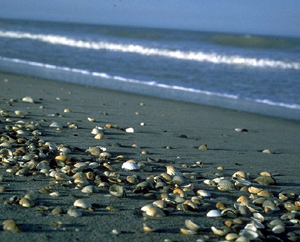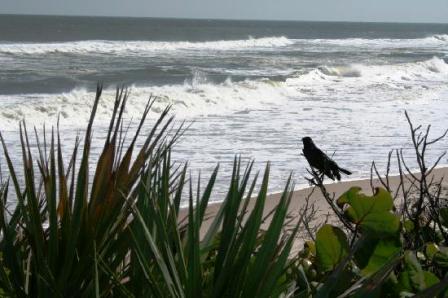Discover Florida Nature
It's time to explore the natural Florida


|
|
|
|
|
 The
Canaveral National Seashore and the Merritt Island Wildlife Refuge are
located midway on Florida’s east coast between Daytona Beach and
Melbourne. The history of Merritt Island extends from prehistoric times
to the space age! Inhabited by Indians since about 7000 B.C., the island
in recent years has rocketed to the site of Cape Canaveral, with which
the refuge and seashore share a border. The National Park Service
protects ten National Seashores in the United States. Canaveral National
Seashore is a step into the past, protection for the present, and a
doorway into the future. The 100
Timucuan Mounds that are
within it's boundaries are evidence of past generations of people that
lived here. Canaveral National Seashore covers 57,000 acres and the 24
mile stretch of undeveloped beach is the longest stretch on Florida's
east coast. Fourteen endangered species make their home within
Canaveral's boundaries. Kennedy Space Center owns the land that is
managed by the National Park Service and Merritt Island National
Wildlife Refuge. Joint efforts of three agencies protect it from
development and preserve the history, the wildlife and the diverse
habitats. The
Canaveral National Seashore and the Merritt Island Wildlife Refuge are
located midway on Florida’s east coast between Daytona Beach and
Melbourne. The history of Merritt Island extends from prehistoric times
to the space age! Inhabited by Indians since about 7000 B.C., the island
in recent years has rocketed to the site of Cape Canaveral, with which
the refuge and seashore share a border. The National Park Service
protects ten National Seashores in the United States. Canaveral National
Seashore is a step into the past, protection for the present, and a
doorway into the future. The 100
Timucuan Mounds that are
within it's boundaries are evidence of past generations of people that
lived here. Canaveral National Seashore covers 57,000 acres and the 24
mile stretch of undeveloped beach is the longest stretch on Florida's
east coast. Fourteen endangered species make their home within
Canaveral's boundaries. Kennedy Space Center owns the land that is
managed by the National Park Service and Merritt Island National
Wildlife Refuge. Joint efforts of three agencies protect it from
development and preserve the history, the wildlife and the diverse
habitats.The seashore spans twenty miles of unspoiled golden sand between Apollo and Palyalinda beaches. District. Boardwalks from the parking areas offer access to the beach protecting the fragile sand dunes from foot traffic. Visitors may choose to hike the distance, stopping to swim and beach-comb, gathering such shells as lightning whelks and angel wings. Other possibilities are are shell fishing, crabbing and surf casting for pompano, bluefish, and other species. Boating canoeing and fishing are also enjoyed at the adjacent Mosquito Lagoon. Visitors will want to make sure to bring both insect repellent and sunscreen!  The
Wildlife refuge can be explored by car along two nature drives or by
foot via two short hiking trails. Either way the range of wildlife is
stunning. Many of the 250 bird species that have been observed here make
their nests on the refuge, including
great blue herons, snowy egrets,
turkey vultures, pi-billed grebes and the
rare black skimmers. The
Wildlife refuge can be explored by car along two nature drives or by
foot via two short hiking trails. Either way the range of wildlife is
stunning. Many of the 250 bird species that have been observed here make
their nests on the refuge, including
great blue herons, snowy egrets,
turkey vultures, pi-billed grebes and the
rare black skimmers. The refuge is also home to nineteen endangered species, most notably the southern bald eagle and the brown pelican. Porpoises, manatees, and whales are occasionally glimpsed offshore. Canaveral National Seashore serves as an important nesting area for sea turtles. During the months of May through August, giant sea turtles lumber ashore to nest on the beach. Three species are know to nest within the park; the loggerhead, leatherback and green sea turtle. Loggerheads lay 3,000 - 4,000 nests per year. Up to three hundred greens and only a few leatherbacks deposit their eggs within the park boundaries each nesting season. The sea turtles lay approximately 100 round, white, leathery eggs in each nest. Prior to 1984, most of the eggs laid within the seashore were eaten by raccoons, and to a lesser extent by ghost crabs. Some nests are lost when beaches erode during storms. In the early 1980's researchers found raccoons were destroying 98 percent of Canaveral's turtle nests. The park began a program to help reverse this trend. After experimenting with several different ways of protecting the eggs, park rangers found that by securing a wire mesh screen over the nest, raccoons were prevented from digging in to the nests. The small hatchlings could still exit the next through the openings in the mesh. During the months of May through August, park rangers and volunteers work each night to screen the nests. After two months, when all the eggs have hatched, the screens are removed. Over 80 percent of the turtle nests have been protected using this method. |
|
|
Canaveral National Seashore Florida
The Canaveral National Seashore and the Merritt Island Wildlife Refuge are located midway on Florida’s east coast between Daytona Beach and Melbourne and Floridian nature abounds there. The Wildlife refuge can be explored by car along two nature drives or by foot via two short hiking trails and is home to 19 endangered species.
The seashore spans twenty miles of unspoiled golden sand between Apollo and Palyalinda beaches. District. Boardwalks from the parking areas offer access to the beach protecting the fragile sand dunes from foot traffic. Visitors may choose to hike the distance, stopping to swim and beach-comb, gathering such shells as lightning whelks and angel wings. Other possibilities are are shell fishing, crabbing and surf casting for pompano, bluefish, and other Florida fish. Boating canoeing and fishing are also enjoyed at the adjacent Mosquito Lagoon. Visitors will want to make sure to bring both insect repellent and sunscreen.Canaveral National Seashore is Floridian nature at its best!
Written by: Floridian Nature
Canaveral National Seashore
Date published: 10/22/2013
4 / 5 stars
|
|